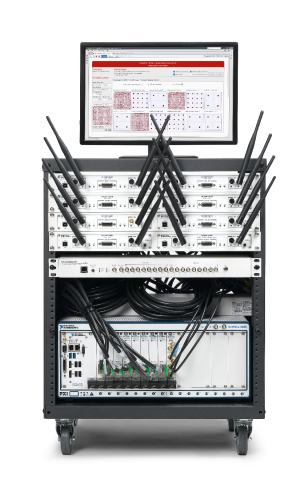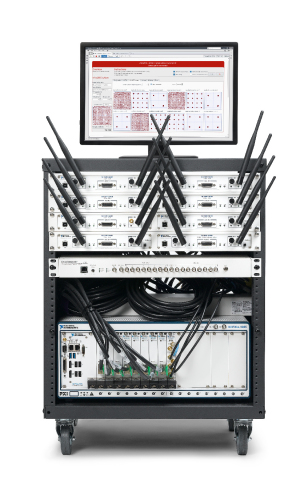AUSTIN, Texas--(BUSINESS WIRE)--NIWeek - NI (Nasdaq: NATI), the provider of platform-based systems that enable engineers and scientists to solve the world’s greatest engineering challenges, today announced the world’s first MIMO Application Framework. When paired with NI software defined radio hardware, this software reference design provides a well-documented, reconfigurable, parameterized physical layer written and delivered in LabVIEW source code that enables researchers to build both traditional MIMO and Massive MIMO prototypes.
The LabVIEW Communications MIMO Application Framework enables wireless designers to develop algorithms and evaluate custom IP to solve many of the practical challenges associated with real-world multiuser MIMO deployments. Scalable from 4 to 128 antennas, the MIMO Application Framework, when used with the NI USRP RIO and NI PXI hardware platforms, enables users to create small to large scale antenna systems with minimal system integration or design effort. Researchers can use the system out of the box to conduct Massive MIMO experiments and seamlessly integrate their own custom signal processing algorithms in a fraction of the time compared to other approaches, thereby accelerating the overall design process as the wireless industry races to define 5G.
As participants in NI’s RF/Communications Lead User program, researchers at Bristol University have used NI’s flexible prototyping platform for 5G research and recently announced in conjunction with Lund University a world-record 22-fold increase in spectral efficiency over modern day 4G networks.
“NI’s MIMO platform has been instrumental in enabling our Massive MIMO research,” said Professor Andrew Nix, Head of the CSN Group and Dean of Engineering at the University of Bristol. “The MIMO Application Framework NI provided allowed our team to begin our work from an advanced starting point, and the seamless interaction between the software and hardware let us move quickly from theory to real-world prototyping. As a result, we were able to prove the potential of Massive MIMO as a candidate technology for 5G by setting world records in spectral efficiency.”
Find more information on the new Massive MIMO Application Framework at www.ni.com/sdr/mimo.
About NI
Since 1976, NI (www.ni.com) has made it possible for engineers and scientists to solve the world’s greatest engineering challenges with powerful platform-based systems that accelerate productivity and drive rapid innovation. Customers from a wide variety of industries – from healthcare to automotive and from consumer electronics to particle physics – use NI’s integrated hardware and software platform to improve the world we live in.
National Instruments, NI and ni.com are trademarks of National Instruments. Other product and company names listed are trademarks or trade names of their respective companies.
About the University of Bristol
The University of Bristol is one of the most popular and successful universities in the UK. It was ranked within the top 40 universities in the world in the QS World University rankings 2015 and 9th in the country. The University of Bristol is ranked among the top five institutions in the UK for its research, according to new analysis of the Research Excellence Framework (REF) 2014.
Bristol is a member of the Russell Group of UK research-intensive universities, and a member of the Worldwide Universities Network, a grouping of research-led institutions of international standing.
The University was founded in 1876 and was granted its Royal Charter in 1909. It was the first university in England to admit women on the same basis as men.
The University is a major force in the economic, social and cultural life of Bristol and the region, but is also a significant player on the world stage. It has over 16,000 undergraduates and nearly 6,000 postgraduate students from more than 100 countries, and its research links span the globe.
Twelve Bristol graduates and members of staff have been awarded Nobel Prizes, including Sir Winston Churchill who was Chancellor of the University of Bristol from 1929 until 1965.




